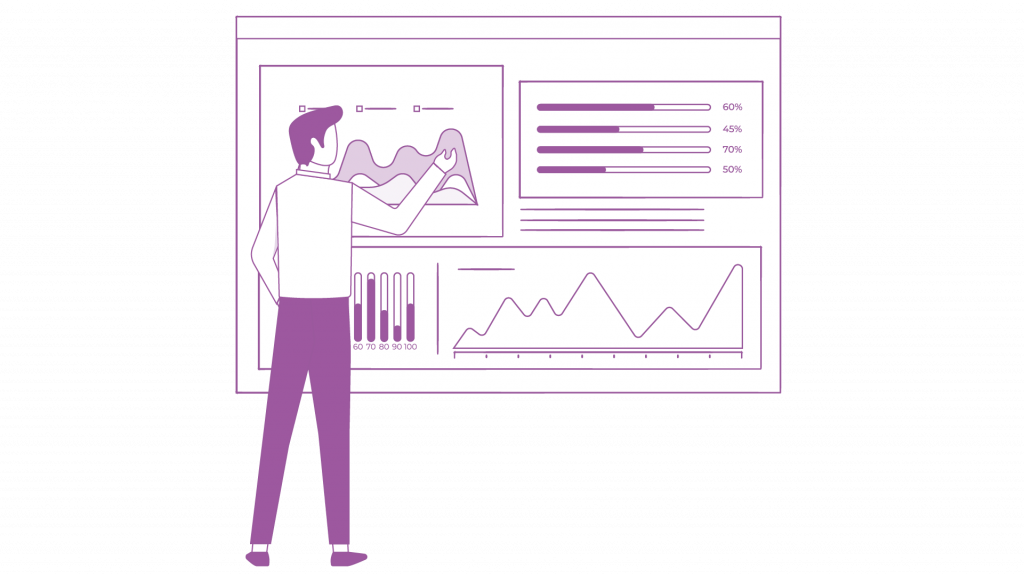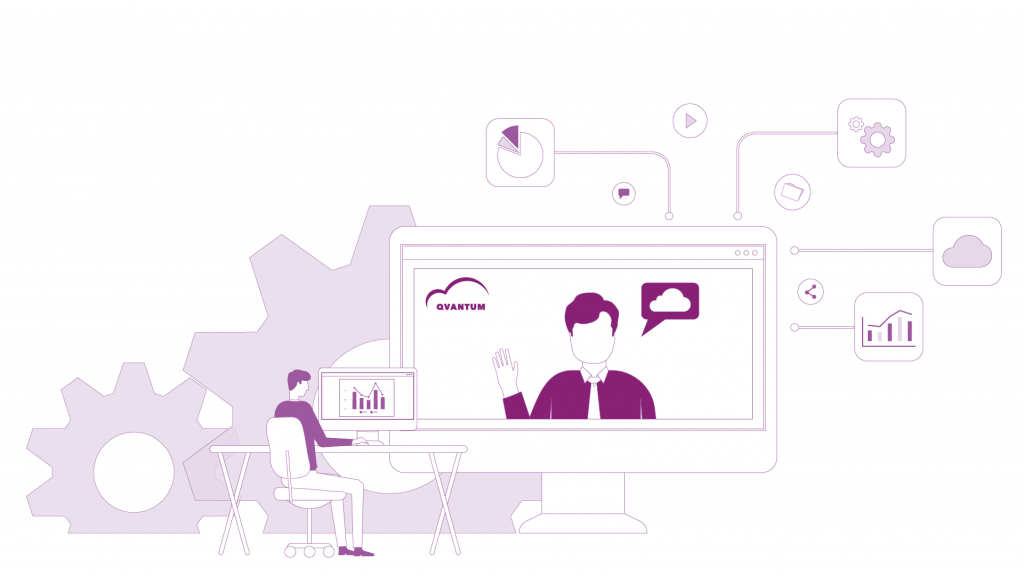How planning in the cloud changes controlling
Everyday life in controlling can sometimes be chaotic and frustrating. Michael Fink knows this all too well. Since 2017, he has been Head of Controlling at the Aachen-based mineral water supplier “Feine Perle Vulkaneifel GmbH” (FPV). His daily routine stands out in many companies in the consumer goods industry. Planning access, consistent planning numbers, agile and fast planning cycles? Not a chance.
For Michael, one thing is clear: this can’t go on. The FPV company chooses planning with our QVANTUM cloud software. It was not his expectation that planning in the cloud would change FPV’s day-to-day controlling by 180 degrees.
Plan or guess?
Monday, May 16, 10 a.m.
“What is the current planning status?” It’s the same question every week. Today, again, Michael Fink, Head of Controlling, doesn’t have an answer. “At the moment, I can’t access our complete planning,” he says apologetically toward his smartphone as he notes which of his colleagues still need to provide data for his corporate planning. “Frank’s planning file is on his computer. He’s sick. I’m trying to reach him to see if he can get the file to me. But I guess we’ll have to do without it for now for the time he is down.”
As Michael hangs up, he is struck by the same uneasy feeling he always has when the CEO quizzes him in the weekly catch-up. The sudden absence of his colleague is doubly inconvenient in the already prevailing planning confusion. A solution must be found. Like so many times before, he finds himself thinking about whether he should add in the missing figures himself.

Everything has to be done yourself
Monday, May 16, 10:15 a.m.
Of course Frank is not available. We’ll have to wait for his data, Michael concludes with a sigh. Time to take care of the already existing plan data. His confident smile quickly gives way to an exasperated snap as he gradually opens the files he’s been looking for in his emails. “We should start sending only protected files out to planners,” he says to himself in alarm.
Flexibility aside. The fact that any user can restructure and add to the tables as they see fit now leaves Michael with an almost insurmountable technical problem. The deviating table edits that his colleagues were highly motivated to make, he now has to manually adjust them all in the overall planning. It’s certainly not the first time, but Michael’s nerves are getting thinner and thinner.
No goal in sight
Tuesday, May 17, 9 a.m.
The moment Michael learns that the sales target of the German national subsidiary has been raised, a thunderstorm breaks over him. His to-do list for this week, no, even the entire planning cycle turns upside down. He was already on the finishing line this week, but now he has to start the entire planning cycle all over again.
Annoyed, he slams his empty coffee cup down on the table. His boss demands results, but constantly something changes from above and everything has to be turned around 10 times. How are we supposed to get an actual result like that? But he is alone with his anger.
There is nothing left for him to do but to start a new collection of adapted Excel folders for each decentralized unit and again collect all Excel sheets from the different departments. This not only takes a lot of time, but also requires time-consuming individual programming to calculate the sales target for the line items in the sales planning.

Inconsistent data: “The needle in the haystack”
Friday, May 20, 1 p.m.
It’s been a while since the message about the changed sales target, but Michael still hasn’t started adjusting his individual planning files. In the jungle of planning data, he is currently desperately trying to find calculation errors in the tables to be adjusted and to explain the logical contradiction that has recently arisen and is now blocking the entire aggregation.
The modeling logic of his planning is as transparent as whiteboard wallpaper at the moment.
On several occasions, Michael has looked around at how other companies are overcoming this challenge. And again and again he gets stuck on the same topic - cloud software. Is planning in the cloud really more effective? How much effort does it take to set everything up and enter it? Being honest with himself, he’s literally bursting with curiosity. But he needs to prepare well for the next team meeting to answer everyone’s questions. He needs to convince not only himself and the CEO, but also his colleagues.

The encounter with the QVANTUM software and a spark of confidence
Wednesday, May 25, 4:20 p.m.
For a long time, Michael feels like he is being heard again. He has taken the step. What he has been quietly working out with himself for a long time has now become a reality. Moving to the cloud suddenly doesn’t seem to be just a silly vision of his. His Google research and the pleasant conversation with QVANTUM’s Customer Success Manager have shown that QVANTUM meets all the goals and requirements that are of high importance in the controlling process. Amazed, he checks off his checklist:
- Current planning process
- Data security and access control
- Transparency
- Interdepartmental cooperation
- Flexibility
- Growing complexity
- Agile planning
- Optimize sales-operation alignment
He had imagined the implementation process to be much more complicated. The most important part is yet to come. A master data briefing is already scheduled before prototyping, in which a first prototype will prove that the company’s own planning model can be implemented. It gets even better. Michael does not have to take care of everything himself. The QVANTUM team calculates the RoI together with Michael to see the savings and the added value provided by QVANTUM directly in all its glory.
Especially at the beginning, he was not sure if his problems could really be solved by the planning software and how to properly evaluate the effectiveness and efficiency of planning in the software. But today, Michael feels a familiar confidence welling up inside him: QVANTUM will definitely help him and soon he will present a whole new planning experience to his team.

First planning in the cloud
Wednesday, June 15, 1 p.m.
It’s done. One consultation with QVANTUM, many internal meetings and two working meetings later, the CEO’s doubts have been removed and Michael is on fire. One thing is clear now: FPV, the premium mineral water supplier, can plan much faster, more efficiently and more transparently with QVANTUM than ever before. Michael’s colleagues were also impressed. They were all able to click through the software themselves and experience for themselves a live experience of what planning in the cloud feels like. It was different, but just as easy and flexible as planning with Excel. Most importantly, however, it was much clearer.
He takes a look at his new QVANTUM account to start a new planning preparation. The first new planning cycle since moving to the cloud. Understandably, Michael’s cheeks flush with excitement. Does the cloud deliver what it promises? They’ve already tested it, but you never know if it will actually prove itself in everyday life. With one click, he uploads his new planning model to the cloud. With a second click, the planning starts. Michael has a habit of double-checking everything and nervously checks to make sure he hasn’t forgotten something. But that’s already it. Just at that moment, his colleagues have received an e-mail with their access data and a personal link to their partial planning.

The age of automation
Friday, June 17, 11:30 a.m.
It’s a mix of surprise, relief and joy that hovers like a cloud over Michael’s office. Now that data merging is practically automatic, his colleagues are entering his office more often again to develop new ideas and fine-tune processes. And Michael has time for that. He can relax and no longer has to go through the grind in his head.
Automated is the key word. It feels like it was in the last century when Michael merged his data himself and unpleasant reminders or phone calls stood between Michael and his colleagues. Now the consolidation of data from the isolated plans of all colleagues happens by itself. Whether it’s aggregating data from bottom-up plans or top-down targets. Michael deposits the dependencies between the key figures and other calculation logics centrally in the planning model and the calculations always take place immediately and automatically.

When control becomes teamwork
Monday, June 27, 10:30 a.m.
Aha, Michael thinks with a grin. Sales region north. Who is responsible for that? The QVANTUM dashboard has the answer. Patrick Mersen. Time for a reminder email from the cockpit. Michael can literally feel the joy he gets from the new way of working. The cloud shows Michael the current progress of his new planning. Best of all, he thinks as he sips his coffee contentedly, he no longer has to chase after everyone and worry about broken files or make manual adjustments resulting from changes to the planning logic.
Most recently, he simply paused his new planning temporarily when there were once again new adjustments. All his colleagues knew immediately, because it wasn’t him but the system that immediately sent an e-mail to inform everyone.
Hard to believe: He almost looks forward to the weekly catch-up with his CEO. Because today Michael has results. The quality of the exchange with the CEO has improved by far. It is now no longer primarily about who Michael has not yet received what from and how far along the planning is, but rather what the current numbers say and how the company should deal with them.

How to take the next step in planning in the cloud
Would you like to experience the same as Michael? Have you been fed up with chaotic and time-consuming planning for a long time? Would you like to speed up your business planning and make quick decisions based on transparent and up-to-date data? Let us show you what cloud planning can look like for your business, how we can work with you and customize our planning model to meet your needs.
Book a non-binding consultation appointment with us right here. We will clarify all further questions and details in a personal online call.


